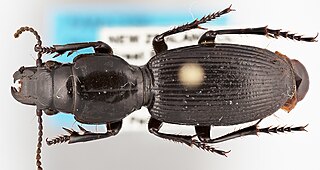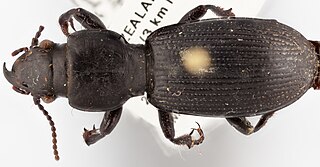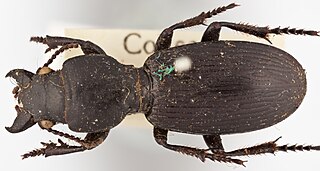
Dorcus is a genus of beetles in the family Lucanidae. Of the 30-odd species, most occur in Asia and India; two are found in southern Europe, and two species are from North America. Previously, specimens with serriform teeth on the mandibles and sable pigment were called Serrognathus whereas specimens with but a singular or multiple bulky notches on the mandibles and lustrous sable pigmentation were called Dorcus. Serrognathus was recently reclassified and merged into the genus Dorcus.

Mugil is a genus of mullet in the family Mugilidae found worldwide in tropical and temperate coastal marine waters, but also entering estuaries and rivers.

Dorcus curvidens is a species of stag beetle.
Ptychochromis curvidens is an endangered species of fish in the cichlid family. It is endemic to a few rivers that flow west from Montagne d'Ambre in far northern Madagascar. It is threatened by habitat loss and introduced species. It reaches about 14.7 cm (5.8 in) in standard length.
Hierodula werneri is a species of praying mantis in the family Mantidae.

Abatus curvidens is a species of sea urchin of the family Schizasteridae. Their armour is covered with spines. It is in the genus Abatus and lives in the sea. Abatus curvidens was first scientifically described in 1836 by Ole Mortensen.

Abatus koehleri is a species of sea urchin of the family Schizasteridae. Their armour is covered with spines. It was first scientifically described in 1908 by Koehler. It is known from the South Orkneys.
Plesioptopoma curvidens is a species of armored catfish native to Brazil, where it is known to occur in the Rio Paraopeba, a tributary of the Rio São Francisco. It is the only species in the genus Plesioptopoma. This species reaches a maximum length of 8.3 centimetres (3.3 in) (SL).

Ithystenus curvidens is a species of straight-snouted weevils belonging to the family Brentidae.
Abaraeus is a genus of longhorn beetles of the subfamily Lamiinae, containing the following species:

Dorcus rectus, the little stag beetle, is a species of beetles in the family Lucanidae. It is found in Japan. These beetles have a distinctive red shell that separates them from Dorcus curvidens.

Mecodema aoteanoho is a medium-sized ground beetle, the only such beetle endemic to Great Barrier Island (Aotea), Hauraki Gulf, Auckland, New Zealand. Mecodema aoteanoho is a sister species to M. haunoho and is closely related to the Coromandel (mainland) species, M. atrox, all of which are species within the monophyletic curvidens group. There are a number of other characters that distinguish M. aoteanoho from all other North Island Mecodema, especially the pattern of the striations on the elytra.

Mecodema haunoho is the only ground beetle (Carabidae) species that is endemic to Little Barrier Island (Hauturu). It is sister species the Great Barrier Island (Aotea) species M. aoteanoho and both are closely related to M. manaia, a species found in Bream Head, Northland, New Zealand.

Mecodema kokoromatua is a medium-bodied ground beetle endemic to Northland, New Zealand. Its range is restricted to coastal forest behind the sand dunes and below the southern areas of the Ahipara Escarpment, Herekino, Northland, New Zealand. This species is within the curvidens species group and is related to the geographically widespread M. parataiko.

Mecodema manaia is a medium-sized ground beetle species found in the native forests of Bream Head and Mt Manaia, Northland, New Zealand. This species shares the forests of Bream Head with a large-bodied species, M. tewhara, with both inhabiting slightly different forest type.

Mecodema atrox is a medium-sized ground beetle species that is closely related to Mecodema curvidens. Mecodema atrox is relatively rare in comparison due to its preferred habitat, the coastal broadleaf forests of the Coromandel Peninsula, a forest type that is in decline. The body of Mecodema atrox is black and the legs are dark reddish-brown. They can be distinguished from other Mecodema species by a number of characters, including the pattern of asetose punctures along the elytral striae.

Mecodema curvidens Broun is a medium-bodied ground beetle that is geographically widespread throughout the central areas of the North Island, New Zealand, which includes the entomological regions of Auckland (AK), Waikato (WO), Coromandel (CL), Bay of Plenty (BP), Taupo (TO), Rangitikei (RI), Whanganui (WI), Hawkes Bay (HB) and Wellington (WN). Recently, the species M. occiputale Broun was synonymised under M. curvidens. Mecodema curvidens is relatively common through its range except in the southern area of the Hunua Ranges (Auckland) and Wellington regions.
Mecodema oregoides is a small-bodied ground beetle endemic to New Zealand, and is the southernmost species of the curvidens group. It is found in a range of different habitats on Banks Peninsula, Canterbury.

Abatus is a genus of sea urchins belonging to the family Schizasteridae.

Acanthodis is a genus of katydids belonging to the family Tettigoniidae.














